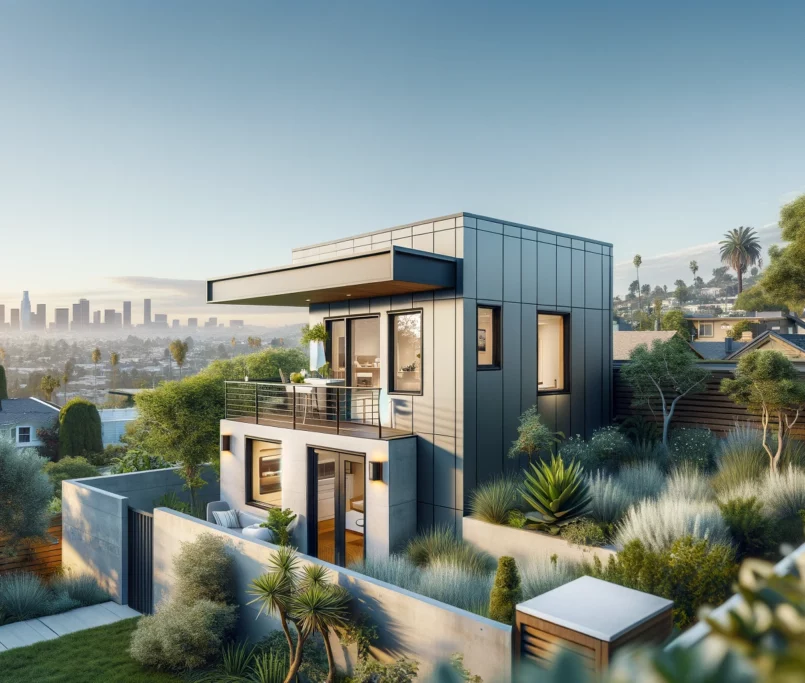Accessory Dwelling Units (ADUs), often referred to as granny flats, in-law units, or backyard cottages, have surged in popularity as a versatile real estate solution. These compact living spaces, located on the same grounds as a primary residence, offer homeowners a unique opportunity to generate substantial rental income. This article delves into the world of ADUs, highlighting their potential as a lucrative investment and guiding homeowners on how to navigate the complexities of creating a rentable ADU on their property.
What are ADUs?
ADUs are small, self-contained homes that can be either attached to or detached from a primary dwelling. They come in various forms, including basement conversions, over-garage apartments, and stand-alone backyard units. The flexibility of ADUs makes them an attractive option for property owners looking to maximize their land use and accommodate a range of needs, from housing extended family to generating rental income.
Legal and Zoning Considerations
Before embarking on an ADU project, it’s crucial to understand the legal framework and zoning regulations in your area. Most municipalities have specific guidelines covering ADU size, placement, and design, ensuring they fit within the character of the neighborhood and meet safety standards. Familiarizing yourself with these regulations early in the planning process can save time and prevent potential legal hurdles.
Benefits of ADUs for Rental Income
Additional Income Stream
One of the most compelling reasons to build an ADU is the potential for an additional income stream. Renting out an ADU can provide a steady flow of revenue, helping homeowners offset mortgage payments, cover maintenance costs, or simply boost their monthly income. This is particularly attractive in high-demand rental markets where affordable housing options are scarce.
Property Value Increase
Investing in an ADU can significantly increase the overall value of your property. These units add functional living space, which is a key factor in real estate valuation. Potential buyers often view ADUs as an advantageous feature, offering the possibility of rental income or multi-generational living options.
Meeting Housing Demand
In many urban areas, the demand for affordable housing outstrips supply. ADUs can play a crucial role in alleviating this shortage by providing more housing units within existing residential areas. This not only benefits homeowners but also contributes to the broader community by diversifying housing options.
Costs and Investments
Initial Construction Costs
The cost of building an ADU varies widely based on size, location, design choices, and construction materials. Homeowners should budget for all aspects of construction, including planning, permits, labor, and materials. It’s also wise to allocate a contingency fund for unforeseen expenses.
Ongoing Maintenance and Management Expenses
Owning a rental property comes with ongoing maintenance and management responsibilities. Regular upkeep, repairs, and potential property management fees should be factored into the financial planning of your ADU project to ensure it remains a viable income source over time.
Financing Options and ROI Analysis
Various financing options are available for ADU projects, including home equity loans, personal loans, and specialized ADU financing programs. Conducting a thorough return on investment (ROI) analysis can help homeowners evaluate the financial viability of an ADU project, taking into account the initial outlay, ongoing expenses, and potential rental income.
Regulations and Permits
Navigating Local Zoning Laws
Understanding and complying with local zoning laws is paramount when planning an ADU. These regulations can affect the size, location, and features of your ADU. Early consultation with zoning and planning departments can provide clarity and streamline the approval process.
Permitting Process and Compliance
Securing the necessary permits is a critical step in the ADU development process. This typically involves submitting detailed plans and undergoing inspections to ensure the unit meets all building codes and safety standards. While the permitting process can be time-consuming, adherence to regulations protects the homeowner and ensures the longevity and legality of the ADU.
Impact of Regulations on ADU Design and Placement
Local regulations may also dictate the design and placement of your ADU. Restrictions on height, setback, and architectural style can influence your design choices. It’s essential to work within these parameters while finding creative ways to maximize the functionality and appeal of your ADU.
Design and Construction Tips
Maximizing Space and Efficiency
When designing an ADU, every square foot counts. Efficient use of space is crucial, and smart design choices can make even the smallest units feel spacious and functional. Incorporating built-in storage, multi-functional furniture, and thoughtful layouts can enhance livability without increasing the footprint.
Sustainable and Eco-Friendly Practices
Sustainability is a growing concern in construction, and ADUs offer a unique opportunity to implement eco-friendly practices. Consider using energy-efficient appliances, sustainable building materials, and incorporating green spaces. Not only do these choices reduce the environmental impact, but they can also lead to long-term savings on utility costs.
Contractor Selection and Project Management
Choosing the right contractor is vital to the success of your ADU project. Look for professionals with experience in ADU construction who can navigate the complexities of permits and regulations. Effective project management, clear communication, and a well-defined contract can help ensure the project stays on budget and schedule.
Case Studies and Success Stories
To illustrate the potential of ADUs, let’s look at a couple of success stories:
- Urban Studio ADU: In a bustling city, a homeowner transformed their unused garage into a modern studio ADU. The project cost $120,000 and was completed in six months. The unit now rents for $1,800 per month, offering the homeowner a strong return on investment while providing much-needed affordable housing in the area.
- Backyard Cottage: A family in a suburban neighborhood built a two-bedroom cottage in their spacious backyard. The construction cost was $200,000, and the cottage rents for $2,500 per month. This ADU not only serves as a significant income source but has also increased the property’s overall value.
These examples demonstrate the versatility and financial benefits of ADUs, highlighting how they can be tailored to fit different properties and meet the housing needs of diverse communities.
Conclusion
ADUs represent a unique opportunity for homeowners to generate rental income, increase property value, and contribute to the availability of affordable housing. By understanding the benefits, navigating the regulatory landscape, and employing smart design and construction practices, you can maximize the potential of your property.
If you’re considering adding an ADU to your property, now is the time to explore this investment opportunity. Look no further










